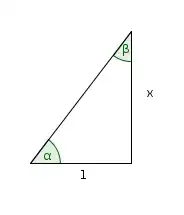Verify the identity: $\tan^{-1} x + \tan^{-1} (1/x) = \frac\pi 2, x > 0$
$$\alpha= \tan^{-1} x$$
$$\beta = \tan^{-1} (1/x)$$
$$\tan \alpha = x$$
$$\tan \beta = 1/x$$
$$\tan^{-1}[\tan(\alpha + \beta)]$$
$$\tan^{-1}\left [{\tan\alpha + \tan\beta\over 1 - \tan\alpha \tan\beta} \right]$$
$$\tan^{-1}\left[ {x + 1/x\over 1- x/x }\right]$$
$$\tan^{-1}\left[{x + (1/x)\over 0} \right]$$
I can't find out what I'm doing wrong..
